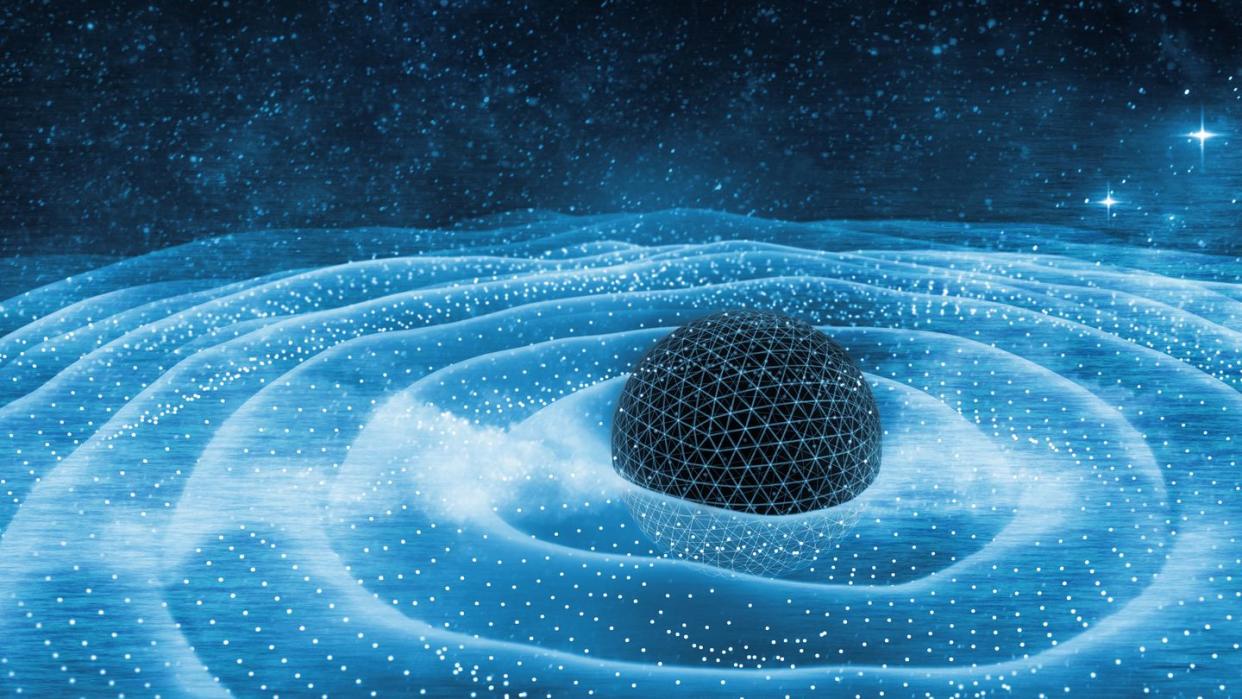Scientists Are About to Chart a Course Through the Fabric of Space-Time

- Oops!Something went wrong.Please try again later.
After a century of searching, scientists finally discovered the first gravitational waves—ripples in spacetime caused by the acceleration of massive objects.
To see these gravitational waves better than ever before, the European Space Agency is sending a trio of satellites to trail Earth around the Sun in order to detect gravitational waves that originated at “the dawn of time.”
Finally adopted as of last week, astronautical engineers will be building the instruments and spacecraft in 2025 with a hopeful launch date in 2035.
As part of his General Theory of Relativity, Albert Einstein predicted that the acceleration of any object with mass—anything from humans to supernovas to merging supermassive black holes—would physically shake the fabric of spacetime and create gravitational waves. Despite his prediction, Einstein readily admitted that these waves might be too faint to ever detect.
Pro tip: never tell an astronautical engineer something is impossible.
In mid-September of 2015, the Laser Interferometer Gravitational-Wave Observatory (LIGO) detected the first gravitational waves ever using two ground facilities—one in Hanford, Washington, and the other in Livingston, Louisiana—1,865 miles apart. Some 90 or so gravitational waves have been detected since then, and researchers have confirmed that the universe is full of these relatively common gravitational occurrences.
While LIGO is great at detecting certain kinds of gravitational waves, the distance of its detector puts a maximum limit on which waves LIGO can detect. LIGO works by sending out a laser pulse that is split into two arms, reflected off mirrors, and sent back to the middle. There, if there’s no gravitational wave, the beams cancel each other out.
But if a gravitational wave passes through (remember, these things affect spacetime itself), it literally changes the length of the arms. As a result, the laser beams take different amounts of time to complete their reflective journey, and don’t completely cancel each other out when they meet back in the middle, and ping! LIGO has spotted another gravitational wave.
To Einstein’s point, however, these waves are incredibly faint. The ones being detected by LIGO are already the strongest of the bunch, and even they are hard to pick up with a detector of this scale. But what if detectors could be 1.6 million miles apart, rather than just a couple thousand like LIGO?
That’s the idea behind the European Space Agency’s Laser Interferometer Space Antenna (LISA) project. First selected as a large-class mission back in 2017, the project was officially adopted as of last week, giving the go-ahead to start building instrumentation and spacecraft.
“To expand the frontier of gravitational studies we must go to space,“ LISA lead project scientist Nora Lützgendorf said in an ESA press release. “Thanks to the huge distance traveled by the laser signals on LISA, and the superb stability of its instrumentation, we will probe gravitational waves of lower frequencies than is possible on Earth, uncovering events of a different scale, all the way back to the dawn of time.”
LISA won’t be just one spacecraft, but three. Once launched in 2035 (fingers crossed) on an Ariane 6 rocket, the trio of spacecraft will trail in Earth’s orbital wake around the Sun, eventually forming an equilateral triangle of three 1.6-million-mile-long sides—six times longer than the distance from the Earth to the Moon. At the heart of these spacecraft are solid gold-platinum cubes (around the size of a Rubik’s cube) that will float freely in their housing. From there, ESA says, “gravitational waves will cause tiny changes in the distances between the masses in the different spacecraft.” The mission tracks these minute changes (down to a billionth of a millimeter) using laser interferometry, the technology that is the foundation of the LIGO experiment.
“The detection of gravitational waves is bringing a totally new dimension to our perception of the universe,” LISA project scientist Oliver Jennrich said in a ESA press statement. “If we imagine that, so far, with our astrophysics missions, we have been watching the cosmos like a silent movie, capturing the ripples of spacetime with LISA will be a real game-changer, like when sound was added to motion pictures.”
If only Einstein could see us now.
You Might Also Like

